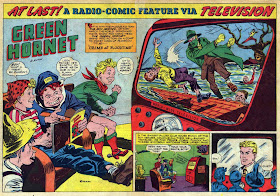The whole country went "Bat-Mad"!
Anything and everything comics-oriented sold like crazy!
Radio syndicator Charles Michelson quickly put together a package of old superhero radio shows including The Shadow, Superman (which featured Batman as a guest-star), The Lone Ranger, and The Green Hornet and marketed them to local radio stations (where, in some cases, ratings doubled) as well as issuing them on LP record albums (which sold well).
 |
| Cover to one of the 1960s LP albums re-presenting classic radio adventures |
Dozier had been listening to the re-issued radio shows and decided The Green Hornet would make a good follow-up to Batman, despite the fact that the last new radio show aired in 1952, and the last new comic (which we presented HERE) was published in 1953!
(Batman had been continually-published since 1939.)
But audience response to the radio show re-runs, especially among adults (who remembered the show) and college students (who were discovering it) was good, so Dozier felt it was worth a try...
| Art by Gil Kane |
Trendle pointed out that doing a "straight" version of his other character, The Lone Ranger, resulted in a long-running TV show and two successful feature films!
So ABC agreed to do it their way...but with some "updating".
| Art by Dan Spiegle |
The Hornet retained his knockout-gas gun, but added an ultrasonic "Hornet Sting", which quickly became his primary weapon.
The Hornet's costume, as described in the radio show and shown in Golden Age comics included a full-face mask that would've required expensive and time-consuming redubbing whenever the character spoke, so it was modified to be a standard domino mask covering just the upper half of the face (see pic at top of page).
Since Batman worked with a police commissioner, The Hornet's police commissioner liaison became District Attorney Frank Scanlon (who, unlike Batman's Commissioner Gordon, knew The Hornet's secret identity and that he wasn't the criminal he pretended to be.)
In a compromise, there were no costumed super-villains, but the gangsters could use cutting-edge technology and unique weapons, like a radio-controlled leopard or a laser gun.
| Art by Gil Kane |
(Note: near the end of the show's run, there was an attempt to introduce more flamboyant enemies including a cloaked assassin and a mad scientist pretending to be an alien invader.)
ABC also insisted that "Flight of the Bumblebee" was too dated to be used as the show's theme. Dozier brought in jazz musician Billy May, who had previously done music for TV shows like Naked City, to compose an updated version.
With trumpeter Al Hirt performing, the new theme became the show's signature element, recognizable almost 50 years later...
The Green Hornet debuted on September 9th, 1966 to solid (but not Batman-level) ratings.
 |
| On-set photo from the Batman episode "Batman's Satisfaction" |
It found a new home in reruns, which are must-see viewing, since the series is not available on VHS/DVD/BluRay!
Though Encore Action Channel, SyFy, and MeTV all re-ran the show over the past decade, none is currently airing it!
Why?
Ironically, since there wasn't a Green Hornet comic book at the time, a new series (based on the TV show) from Gold Key (the premier publisher of Silver Age movie/TV tie-in comics) hit newsstands in late 1966.
Our "brother" RetroBlog, Hero Histories, will be presenting remastered versions of all three issues over the next three weeks beginning Wednesday.
But be HERE this Friday, as we begin a complete re-presentation of The Green Hornet, with each episode presented exactly 50 years after it aired on ABC!
Special Bonus: Want to see what a Green Hornet tv show might have looked like if it had been done in the late 1940s-early 1950s, while the radio show was on?
Click HERE to find out!
Special Bonus: Want to see what a Green Hornet tv show might have looked like if it had been done in the late 1940s-early 1950s, while the radio show was on?
Click HERE to find out!




No comments:
Post a Comment